Positive Health Online
Your Country

Brain-Waves and Altered States of Consciousness
by Dr Peter Grainger(more info)
listed in energy medicine, originally published in issue 165 - December 2009
Introduction
"I think, therefore I am" – Descartes. But what does it mean to think – and what is taking place in our brain to make us who we are? It is in this 'black box' we call the brain that all our thoughts and our very essence reside. Over the years, science has discovered more about the brain and the process of thought and consciousness. Through training, we can alter our state of consciousness and improve learning, behaviour and health. At the Oakspring Clinic, the Author has been using a simplified pocket electroencephalogram (EEG), developed in the West of England, which measures brain-waves and has a specially modified method to assess altered states of consciousness in the application of health and sports performance improvement, in conjunction with hypnosis and guided imagery.
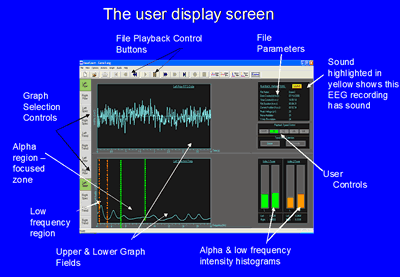
The Brain
The brain is a complex protoplasmic organ of an electro-chemical nature, and it is here that consciousness arises. The potential of this three pound organ of some 109 neurones is still virtually unknown. In spite of this lack of understanding of the brain, humans have exploited these amazing cells with great success and we have gleaned an understanding of our immediate surroundings, resulting in the ability to perceive the Universe almost back to the beginning of time. These cells have produced great people like Mozart, Turner, Shakespeare, Einstein, Dirac, Crick and Watson for example, as well as spiritual and political thinkers and leaders. We can see, hear, feel, smell and model worlds completely separate from reality, appreciate music, encounter religious experience, etc.
But what else are we capable of doing if we can train our brains further, perhaps with the aid of a tool such as an EEG?
One significant progression is the observed chemical and physical structural changes in the brain when it is subjected to cultural diversity. The brain adds nerve cell branches in response to training and learning, irrespective of brain age.
The Electrical Response of the Brain
The brain continually produces a complex electrical pattern which can be measured on the surface of the head using an electroencephalogram (EEG) – (much like the heart's electrical rhythms can be measured on the chest with an ECG). The EEG electrical activity frequency range is divided into five main categories:
- Delta
- Theta
- Alpha
- Beta
- Gamma
in ascending frequency (Hz), with each range having a dominant function (a Hz is a pulse or beat per second).
Figure 1 shows an example of an EEG recording which has peaks in several of these regions – corresponding to brain activity of this type.
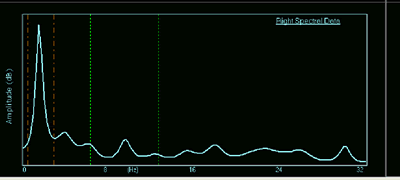
Delta – 0.5 to 4 Hz. The brain is scanning for internal associations, altering internal and external consciousness. Delta waves are essential to the daily function of the body and regulate all aspects of physiology. There is some interesting research suggesting that high amplitude delta waves are frequent in ESP experiences and the '6th sense'. High amplitude seems related to the ability to empathize with other human beings. The delta band also includes other bio-electric signals from, for example, eye blinks, facial movements and possibly ECG, and so should be interpreted with some care.
Theta – 4 to 8 Hz. Full memory search/verbal performance, scanning for pleasure, quiet focus/extroversion/low anxiety, low neuroticism. Theta is closely related to the sleep function and to the necessary restoration of the body. During theta states, the body is actively repairing damage done while awake. Theta is essential to the immune system and the various other systems concerned with growth and duplication. The autonomic nervous system is restored and rebalanced through theta states.
Alpha – 8 to 12 Hz (Berger Rhythm). Scanning for internal/external stimulation/spiritual experiences. Alpha states appear to be closely related to passive waiting. This allows the body and the brain to enter into an energy conservation mode. While it is highly passive, the attention wanders from here to there as the immediate details of the outer world become less and less significant. This is a highly relaxed state and often occurs immediately prior to or following after a stressful event. Alpha serves an important function as the connection between the subconscious and conscious. An alpha state allows for the recollection of dreams, the remembrance of events in meditation, the recall of a creative synthesis of the solution to a daily problem, and the creation of healing images to assist the body to repair and recovery from injury. This state is also associated with high levels of success in sports and performing arts.
Beta – 12 to 22 Hz. Associated with high state of wakefulness, high state of arousal and some drug effects.
Gamma – 22 to 30 Hz. Attention or sensory stimulation, perception and consciousness.
The amplitude of these signals is small – of the order of 10 to 100 microVolts peak to peak (about 1/1000th of an ECG signal), making accurate and reliable measurements difficult.
Thus the EEG signal is the summation of brain cell synaptic firing originating from the cerebral cortex.
EEG and Altered Sates of Consciousness
General anaesthesia, sedation and hypnosis can be considered to be different states of the same continuum, ranging from death, coma, to full cognitive awareness and beyond to hyper-arousal. There is, however, no readily recognisable component of the raw EEG signal that delineates states along this continuum; but spectral analysis has shown that synchronized firing of neurones can develop into brain rhythms associated with different mental states. A good introduction to the EEG is provided by [1]. The alpha band is of great interest in both medicine and sports science together with the delta band in general anaesthesia. The conventional way to display an EEG spectrum is using Fast Fourier Transforms (FFT) but this has several problems: spectral leakage, poor performance under conditions of low signal levels, resulting in low signal to noise ratio. Movement artefacts and electrical interference (especially those caused by surgical diathermy equipment) are a major problem in FFT analysis systems. The shortcomings of the FFT have largely been overcome by the pocket EEG system that the Author has been evaluating.
The Author has found use of this EEG monitoring and recording system has a valuable role to play in 'soft' medical applications. Uses include medical hypnosis, forensic hypnosis, relaxation, meditation and guided visualization, for example.
Sports Medicine
The value of psychological components contributing to success in many forms of sporting endeavour has come to prominence in recent years. Some are clear to the player and bystanders like the 'yips' in golf – focal dystonia,[2] and others are hidden, but nonetheless important for peak performance. The 'relaxed but focused' state or zone has been the subject of much research [3,4,5] but this has mainly been conducted under laboratory conditions. There seems to be a strong correlation of alpha activity with the zone, and it was clear that the pocket EEG with its advantages over the FFT would be very suitable for players on the move.
A feasibility trial was carried out on some highly trained young athletes. Several sports were represented, and all the participants showed that they were capable of getting into the zone of high alpha index while practising simulated competitive actions. For example, a Judo expert wore a baseball cap with electrodes around the rim. In spite of the large amount of movement, the alpha trend was clearly displayed and corresponded to peaks of focused concentration .
Figure 2 below shows a recording for a skilled athlete performing a target based sport. The trace shows the trend versus time for the entire 2.5 minute recording period. Cycles of changing Alpha wave pattern can clearly be seen (green trace) corresponding with 7 (practice) shots taken. The orange upper trace is the low-frequency region (0.5 – 3 Hz).
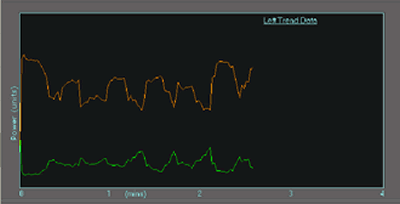
Figure 3: Alpha index trend of the Judo player
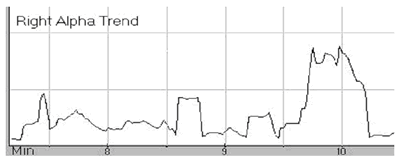
This illustrates that although it may be thought that player-initiated sports such as shooting, archery, golf, would be ideal for zone training, nevertheless player-reacting sports like judo, football, cricket probably have their own zone with high alpha content.
Reviewing EEG feedback with synchronized sound recording (provided as part of the pocket EEG product system) and performance video recording, promises to be a powerful training tool.
Psycho-neuro-immunology (PNI). Through the use of guided imagery, the immune system can be boosted. The patient is placed into a relaxed/hypnotic state and shown their immune system fighting infection. This method has been shown to improve efficacy of cancer treatment and to significantly extend life expectancy along with improved quality of life. [6,7,8]
Stress-relief. Through the use of relaxing music and positive suggestions, a therapist can teach clients to reduce and control their stress levels thus improving health, productivity and quality of life. Again, the Alpha peak is often the sign of success.
Neuro-feedback and neuro-meditation. EEG neuro-feedback is a relatively new and exciting therapy for enhancing health and performance. EEG neuro-feedback educates the brain to produce specific brainwaves in specific locations in the cortex. In a real sense, this process is educational rather than therapeutic. By providing the brain with direct feedback into its own function, the brain is capable of re-educating itself to achieve the necessary homeostasis to healthy functioning. EEG neuro-feedback serves to achieve that re-education after a clinical diagnostic session, to which the person is evaluated and the areas of discomfort and stress identified; the particular sites of re-education are identified along with certain desired frequency and amplitude levels. EEG neuro-feedback methods of re-education involve the application of electrodes to identified brain locations on the scalp which feeds the various brainwaves directly onto a computer screen. Through various sounds, sights and colours, the individual is made aware of the goal to be achieved which is the production of certain brainwaves at a certain amplitude.
EEG neuro-feedback provides a valuable tool for both the therapist and the patient. It also suggests a shift in the classical medical and psychiatric paradigm. The patient assumes a much more active and involved role in the process, and with the therapist taking on more of the role of educator and coach. The treatment is capable of being time monitored and statistically followed for each patient, which is important for the requirements of managed care organisations.
Medical Hypnosis and Conscious Sedation
Hypnosis is an altered state of consciousness and can be a powerful agent in the treatment of many psychosomatic disorders such as irritable bowel syndrome and psychological complaints such as agoraphobia, anxiety states and phobias. It has been used to boost the immune response [9] and as an adjuvant in cancer therapy. A good book on hypnosis is [10]. However, the problem that has bedevilled hypnotherapy since Mesmer's time is the large variation in susceptibility to hypnotic suggestion within the population. Tests have been developed to assess susceptibility [11] but it is the contention of the Author that if it is deemed that the patient would benefit from hypnosis, then a way should be found to improve the hypnotic response.
The general view is that it is not possible to assess depth of hypnosis without resort to eliciting hypnotic phenomena such as hand-arm levitation, skin conductance response or compliance with test post-hypnotic suggestions. The clinical study [12] comparing the EEG response in hypnosis with nitrous oxide conscious sedation (a technique familiar to dentists) showed that there was a good association between the hypnotic or sedated state and a strong alpha rhythm, and that resistance to hypnotic suggestion could be reduced by the nitrous oxide, and that both states could be regarded as altered states of consciousness. Once the patient had learned what to expect in deep relaxation, this chemical sedation could be stopped.
The Author has used EEG monitoring routinely in a pain relief clinic for some years, administering nitrous oxide or, later, enflurane (a volatile inhalational anaesthetic agent)[13] as necessary. It is invaluable to be able to see if the patient is sufficiently relaxed and in an alpha state so that therapy is effective. Deeper hypnosis is associated with a lowering of the alpha frequency and appearance of theta waves, often as a double peak in the spectrum, the so-called alpha-theta state beloved by psychotherapists. Clearly the use of anaesthetic agents, however weak, should only be done in a hospital or dental surgery setting where resuscitation equipment is available, but a safe non-drug technique that shows great promise is the binaural beat method where EEG responses can be induced by pink noise fed to each ear. The phase differences of the two signals are caused to beat at the same frequency as the desired brain rhythm [14,15].
Benzodiazepines such as diazepam and other psychotropic drugs are notorious for undermining hypnotherapy efforts, possibly because of a reduction of the memory of the therapeutic suggestions, but often they can be detected by the level of beta activity of the EEG.
As an aside, the Author had a female patient being treated for chronic pain with enflurane being used as a light sedative. The patient asked if she could have help with binge chocolate eating if there was time at the end of the hypnosis session. During the pain treatment part of the session, the patient produced a very good alpha peak which was consistent throughout the treatment. However, once the session turned to binge eating, the alpha peak collapsed. This indicated a conflict. At a conscious level the patient wanted to achieve a set goal, but subconsciously there was a fear of this goal.
It is this ability to continuously monitor and record patient EEG that the Author has found to be immensely helpful and he was able to more accurately and successfully tailor a treatment session to each patient's needs.
Hardware Configuration
The pocket EEG software loads easily onto a laptop computer and the EEG module is plugged into one of the USB ports as shown in Figure 4.
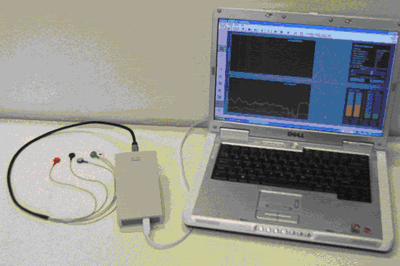
The five electrodes are self adhesive and located on the head as shown in Figure 5.
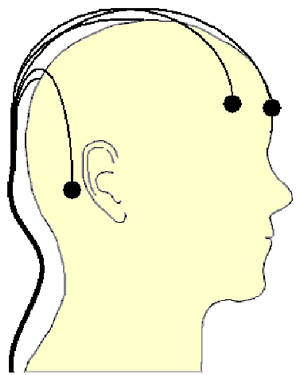
The centre of forehead electrode acts as reference. The electrodes behind the ear – approximately on the mastoid, are the negative connections. The two other electrodes are the positive connection located on the frontalis muscle.
Figure 6 shows the normal use display screen with Figure 7 showing an Alpha peak.

The trace in Figure 7 clearly shows a good peak in the alpha region indicating subject in a very relaxed mental state.
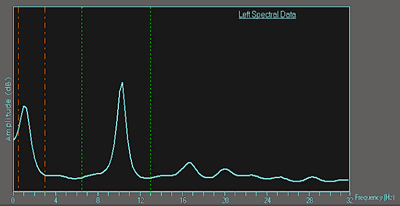
Figure 8 shows the trend in the intensity versus time (green trace). The upper display (blue trace) shows the spectrum at approximately 3.3 minutes, which corresponds to the last point in the intensity versus time trace.
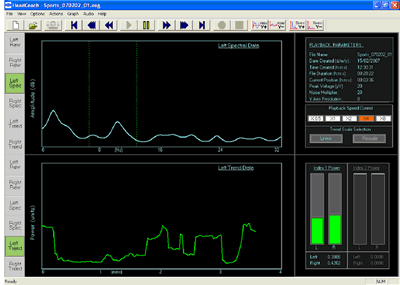
A more detailed description of the equipment is given in [16].
Conclusions
The brain still has many secrets to reveal. With the aid of this relatively simple and easy to use and interpret pocket EEG system, the Author believes practitioners of altered states of consciousness will be able to offer a more sound clinical service and be able to more analytically progress research in this exciting area of health care.
References
1. Fisch BJ. Fisch and Spehlmann's EEG Primer. Elsevier. ISBN 0-444-82148-1. 1999.
2. McDaniel KD, Cummings JL, Shain S. The 'yips': a focal dystonia of golfers. Neurology, 39(2 Pt 1): 192-195. 1989.
3. Hatfield BD, Landers DM, Ray WJ. Cognitive processes during self-paced motor performance: An electroencephalographic profile of skilled marksmen. Journal of Sport Psychology 6: 42-59. 1984.
4. Loze GM, Collins DJ, Cremades JG. EEG measures of cerebral activation during tasks differing in both cognitive and attentional demands. Journal of Sports Sciences 16: 91-92. 1998.
5. Hatfield D, Haufler AJ, Hung T, et al. Electroencephalographic Studies of Skilled Psychomotor Performance. Journal of Clinical Neurophysiology 21(3): 144-156. 2004.
6. Walker GL. Hypnosis and cancer: most defences, quality of life and survival. Contemporary Hypnosis 15(1): 34-38. 1998.
7. Walker GL, Heys SD, Eremin O. Surviving cancer: do psycho-social factors count? Journal of Psychosomatic Research 47(6): 497-503. 1999.
8. Walker L, Walker MB, et al. Psychological, clinical and pathological effects of relaxation training and guided imagery during primary chemotherapy. British Journal of Cancer 80(1/2): 262-268. 1999.
9. Ruzyla-Smith P, Barabasz A, Barabasz M, et al. Effects of hypnosis on the immune response: B-cells, T-cells, helper and suppressor cells. American Journal of Clinical Hypnosis 38(2): 71-79. 1995.
10. Heap M, Aravind KK. Hartland's Medical and Dental Hypnosis Fourth edition. Churchill Livingstone. ISBN 0 443 07217 5. 2002.
11. Weitzenhoffer AM, Hilgard ER. Stanford Hypnotic Susceptibility Scale, Form C. Consulting Psychologists Press. Palo Alto, CA. 1962.
12. Griffiths M, Preece A. Detection and enhancement of the hypnotic state in susceptible and resistant subjects. Journal of the Forensic Science Society 24(4): 359. 1984.
13. Griffiths M, Preece A, Green J. Monitoring sedation levels by EEG spectral analysis. Anesthesia Progress 38: 227-231. 1991.
14. Atwater FH. The Hemi-Sync Process . The Monroe Institute. www.monroeinstitute.org/research. 1997.
15. Brady B, Stevens L. Binaural-beat induced theta EEG activity and hypnotic susceptibility. American Journal Clinical Hypnosis 43(1): 53-69. 2000.
16. Griffiths MJ, Grainger P, et al. Recent Advances in EEG Monitoring for General Anaesthesia, Altered States of Consciousness and Sports Performance Science 3rd IEE International Seminar on Medical Applications of Signal Processing, 3-4 November 2005, ISBN 0-86341-570-9/9-78086341-415708.
Acknowledgements
The Author is grateful to Alpha-Active Ltd, Honiton, Devon for the provision of EEG images and the loan of their pocket EEG equipment: www.alpha-active.com
Comments:
-
karthikeyan.s said..
Dear sir i got nany information from ur article iam doing project in person mind state analysing kindley give guidence
-
RAFAEL Dorta said..
Please i need know if you have machine or device to monitor hypnoterapi level state
-
RAFAEL Rivera Dorta said..
I see you device how much money cost. This device is compatble wich window 7. Please send my more information that posible. Do you speak spanish language.
Thank you